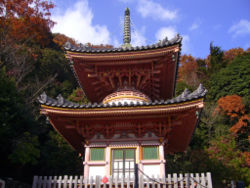
Kanno-ji
Encyclopedia

Mount Kabutoyama
is a mountain in Nishinomiya, Hyōgo, Japan. It is located in the east end of the Rokko Mountains, and the height is 309.2m.- Outline :Mount Kabuto is a famous picnic spot in the Kansai metropolitan area. It is a monadnock of an extinct volcano that was last estimated to have erupted about...
in Nishinomiya, Hyōgo
Hyogo Prefecture
is a prefecture of Japan located in the Kansai region on Honshū island. The capital is Kobe.The prefecture's name was previously alternately spelled as Hiogo.- History :...
, Japan
Japan
Japan is an island nation in East Asia. Located in the Pacific Ocean, it lies to the east of the Sea of Japan, China, North Korea, South Korea and Russia, stretching from the Sea of Okhotsk in the north to the East China Sea and Taiwan in the south...
. The other name of the temple is Kabutoyama-daishi (甲山大師).
Objects of Worship
The original object of worship at this temple was Mount Kabutoyama. In this region, Mount Kabutoyama was believed to be "a mountain of god". Until the Edo periodEdo period
The , or , is a division of Japanese history which was ruled by the shoguns of the Tokugawa family, running from 1603 to 1868. The political entity of this period was the Tokugawa shogunate....
, the temple was a mixture of Shintoism and Buddhism, as many Japanese temples or shrines. Today, the main object of worship at this temple is a statue of Nyoirin (如意輪半跏像). The statue is known as one of the three most famous Nyoirin statues in Japan, with those of Kawachi-Kannon-ji temple in Osaka Prefecture
Osaka Prefecture
is a prefecture located in the Kansai region on Honshū, the main island of Japan. The capital is the city of Osaka. It is the center of Osaka-Kobe-Kyoto area.- History :...
and Murō-ji
Murō-ji
is a temple of Omoto school of Shingon Buddhism, located in the city of Uda, Nara, Japan.Murō-ji shows its typical aspect of Shingon Buddhism, with its buildings laid on the mountainside of .Unlike many temples of the time, Murō-ji was opened to females...
temple in Nara Prefecture
Nara Prefecture
is a prefecture in the Kansai region on Honshū Island, Japan. The capital is the city of Nara.-History:The present-day Nara Prefecture was created in 1887, making it independent of Osaka Prefecture....
.
History
According to Genko-Shakusho (元亨釈書), a famous history of Japanese Buddhism written in the fourteenth century, Kannō-ji was established by the fourth queen of Emperor JunnaEmperor Junna
was the 53rd emperor of Japan, according to the traditional order of succession. Junna reigned from 823 to 833.-Traditional narrative:Junna had six Empresses and Imperial consorts and 13 Imperial sons and daughters...
. However, another history, Teio-Hennnenki, writes that Ujikimi Tachibana (橘氏公) and Shunjo Mihara (三原春上) established the temple at the command of Empress Masako, the first queen of Emperor Junna in 827.
Genko-Shakusho wrote that the fourth queen of Emperor Junna secretly escaped from the Royal Palace in Kyoto
Kyoto
is a city in the central part of the island of Honshū, Japan. It has a population close to 1.5 million. Formerly the imperial capital of Japan, it is now the capital of Kyoto Prefecture, as well as a major part of the Osaka-Kobe-Kyoto metropolitan area.-History:...
and moved to Mount Kabutoyama
Mount Kabutoyama
is a mountain in Nishinomiya, Hyōgo, Japan. It is located in the east end of the Rokko Mountains, and the height is 309.2m.- Outline :Mount Kabuto is a famous picnic spot in the Kansai metropolitan area. It is a monadnock of an extinct volcano that was last estimated to have erupted about...
in 828 with Kūkai
Kukai
Kūkai , also known posthumously as , 774–835, was a Japanese monk, civil servant, scholar, poet, and artist, founder of the Shingon or "True Word" school of Buddhism. Shingon followers usually refer to him by the honorific titles of and ....
's help. Kūkai made a statue of Nyoirin of woods in Mount Kabutoyama in 830, and built the main building of the temple next year.
Cultural Properties
This temple has four national Important Cultural PropertiesImportant Cultural Properties of Japan
The term is often shortened into just are items officially already classified as Tangible Cultural Properties of Japan by the Japanese Agency for Cultural Affairs and judged to be of particular importance to the Japanese people....
selected by the Japanese government.
- Nyoirin-Kannon-Zazo(木造如意輪観音坐像), Heian periodHeian periodThe is the last division of classical Japanese history, running from 794 to 1185. The period is named after the capital city of Heian-kyō, or modern Kyōto. It is the period in Japanese history when Buddhism, Taoism and other Chinese influences were at their height...
- Hijiri-Kannon-Ritsuzo(木造聖観音立像), Heian period
- Fudomyoo-Zazo(不動明王坐像), Kamakura periodKamakura periodThe is a period of Japanese history that marks the governance by the Kamakura Shogunate, officially established in 1192 in Kamakura by the first shogun Minamoto no Yoritomo....
- Kobodaishi-Zazo(弘法大師坐像), Kamakura period
See also
- For an explanation of terms concerning Japanese Buddhism, Japanese Buddhist art, and Japanese Buddhist temple architecture, see the Glossary of Japanese BuddhismGlossary of Japanese BuddhismThis is the glossary of Japanese Buddhism, including major terms the casual reader might find useful in understanding articles on the subject. Words followed by an asterisk are illustrated by an image in one of the photo galleries...
.
Access
- Koyoen StationKoyoen Stationis a railway station in Nishinomiya, Hyōgo Prefecture, Japan, on the Kōyō Line operated by the Hankyu Railway. Kōyōen Station has access to Mount Kabutoyama and the Tsumagari cake shop nearby....
of Hankyu Koyoen Line - Kabutoyama-daishi-mae Bus Stop of Hankyu Bus or Hanshin Bus

